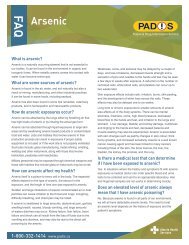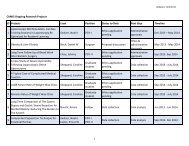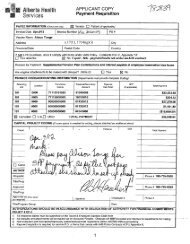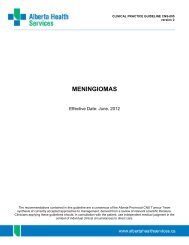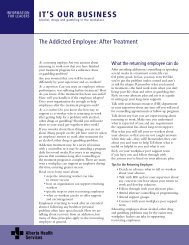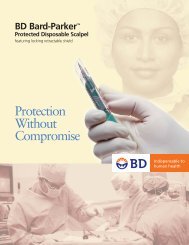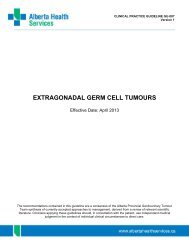Cold Chain Management - Alberta Health Services
Cold Chain Management - Alberta Health Services
Cold Chain Management - Alberta Health Services
You also want an ePaper? Increase the reach of your titles
YUMPU automatically turns print PDFs into web optimized ePapers that Google loves.
1. Refrigerators for vaccine storage<br />
<strong>Cold</strong> <strong>Chain</strong> <strong>Management</strong><br />
1.1. Laboratory-grade refrigerator—highly recommended.<br />
� This is a purpose-built unit that responds well to temperature fluctuations.<br />
1.2. Domestic refrigerator<br />
� These are designed for food storage and not for the requirements of vaccine storage<br />
� Precautions and fridge modifications are needed in order to store vaccines. 1<br />
� There are two types of domestic refrigerators:<br />
- Frost-free (recommended) - they provide more uniform temperatures.<br />
- Manual/cyclic defrost - there are significant temperature variations and are not<br />
recommended.<br />
1.3 Bar-style refrigerator—not recommended<br />
� This unit is unpredictable in terms of maintaining temperatures and should not be used for<br />
overnight vaccine storage.<br />
� When this unit is used, diligent monitoring of temperature is essential.<br />
1.4 An y refrigerator<br />
� Whenever possible, medications and/or other products (e.g., lab specimens) should not<br />
be stored with vaccines.<br />
� If medications and/or other products (e.g., lab specimens) must be stored in the vaccine<br />
storage unit, they must not be stored on the same tray/container as the vaccine to avoid<br />
medication error.<br />
2. Thermometers for monitoring vaccine temperature<br />
2.1 Minimum and maximum thermometers<br />
� These are available in fluid-filled and digital forms<br />
MinMax Digital Digital w/standard probe Digital w/biosafe liquid encased probe<br />
1 Reference: Public <strong>Health</strong> Agency of Canada (2007). National Vaccine Storage and Handling Guidelines for Immunization Providers<br />
Influenza Vaccine Storage and Handling 1 of 4<br />
<strong>Cold</strong> <strong>Chain</strong> <strong>Management</strong><br />
September 9, 2011
� Digital thermometers have two components:<br />
1. A display that mounts to the outside of the refrigerator unit, and<br />
2. A probe on a cord (usually 1 to 3 meters long) that is placed inside the refrigerator unit<br />
(allows the temperatures to be read without opening the door).<br />
- A setting of +5°C provides the best safety<br />
margin for temperature fluctuations within +2°<br />
and +8° C.<br />
- Those with a min/max feature are easy to read<br />
because they display a number indicating the<br />
temperature and do not require interpretation.<br />
- Accurately monitor temperatures with enclosed<br />
temperature-buffered sensor. Bottle insulates<br />
sensor from rapid temperature changes when<br />
refrigerator door is opened.<br />
Note: Temperature monitoring is the only way to be<br />
certain the unit remains within the recommended range.<br />
2.2 Other types of thermometers are available but not recommended.<br />
These include:<br />
� fluid filled biosafe liquid<br />
� bi-metal stem<br />
� household mercury<br />
N<br />
Fluid filled<br />
biosafe liquid<br />
Bi-metal stem<br />
Household<br />
mercury<br />
Note: The above thermometers are NOT recommended for monitoring refrigerator<br />
temperatures.<br />
Influenza Vaccine Storage and Handling 2 of 4<br />
<strong>Cold</strong> <strong>Chain</strong> <strong>Management</strong><br />
September 9, 2011
3. Handling and storing influenza vaccine<br />
3.1 Influenza vaccine<br />
� Must be monitored and recorded consistently using temperature log sheet according to<br />
work day<br />
- Site staffed up to 9 hours—must monitor/record twice daily<br />
- Site staffed over 9 hours—must monitor/record three times in a 24-hour period; and<br />
- Site staffed over 12 hours—must monitor/record four times in a 24-hour period<br />
3.2 Temperature log sheet<br />
� Should be kept on refrigerator door<br />
� Obtain a copy of the temperature log sheet from public health, or<br />
� Use the sample form in the National Vaccine Storage and Handling Guidelines for<br />
Immunization Providers.<br />
3.3 Storage of vaccine<br />
� Must maintain temperature between +2º and +8º Celsius<br />
� Must store vaccine in the middle of refrigerator and not in the door<br />
3.4 Check expiration date<br />
� Use vaccines that will expire soonest first.<br />
3.5 Date vial when opened<br />
� Important for influenza as vaccine is only potent 28 days after first puncture into the<br />
Fluviral® multidose vial; please check specific product monograph for stability information.<br />
� Record on each vial the date and time the vial was opened.<br />
� Immediately put vial back in the refrigerator or in an insulated container after dose has<br />
been withdrawn.<br />
� Check the shelf life of<br />
each individual vial.<br />
3.6 Keep extra containers of<br />
water in refrigerator for<br />
the sole purpose of<br />
helping to maintain<br />
temperatures.<br />
Influenza Vaccine Storage and Handling 3 of 4<br />
<strong>Cold</strong> <strong>Chain</strong> <strong>Management</strong><br />
September 9, 2011
4. Designated and backup persons responsible for vaccine storage and<br />
handling<br />
4.1 Authorized provider/designate is responsible for ensuring safe storage and handling of<br />
provincially funded vaccine.<br />
4.2 Whenever possible there should be a backup person designated.<br />
4.3 There must also be a designated person who is an authorized provider responsible to audit the<br />
temperature log sheet.<br />
� Person who audits must sign and date the log sheet weekly<br />
5. Ensuring a secure electricity supply<br />
5.1. Protect refrigerator unity power supply<br />
� Avoid outlets with built in circuit switches.<br />
� Avoid outlets activated by a wall switch.<br />
� Use a safety-lock plug or outlet cover.<br />
� Post a “Do Not Unplug” sign next to the refrigerator’s electrical outlet.<br />
� Label the fuses/circuit breakers.<br />
� Consider installing a 24/7 temperature alarm.<br />
6. If the temperature drops below +2º or rises above +8º Celsius<br />
When this happens, it is called a “col d chain break”<br />
6.1 Quarantine the vaccine in a functioning refrigerator.<br />
� Complete a cold chain break report form for funded vaccines and report the incident to<br />
Public <strong>Health</strong> in your area.<br />
� Check product monograph and/or with manufacturer for information on stability of nonprovincially<br />
funded vaccine.<br />
6.2 Vaccines are not hazardous material and therefore can be safely discarded in a sharps<br />
container.<br />
Influenza Vaccine Storage and Handling 4 of 4<br />
<strong>Cold</strong> <strong>Chain</strong> <strong>Management</strong><br />
September 10, 2012



